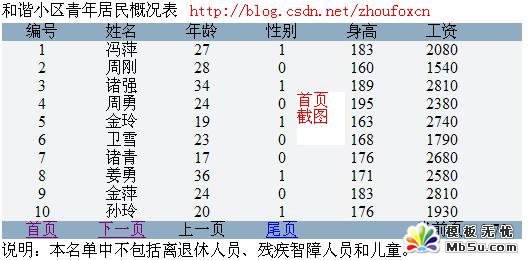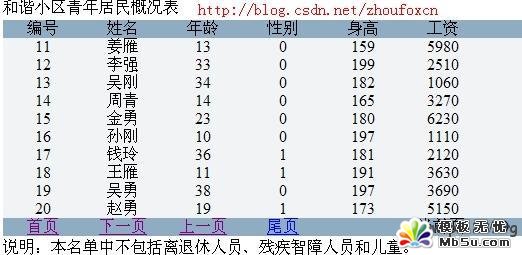怎樣用AjaxPro實(shí)現(xiàn)無(wú)刷新翻頁(yè)效果及數(shù)據(jù)庫(kù)分頁(yè)_AJAX教程
推薦:解析簡(jiǎn)單自定義實(shí)現(xiàn)jQuery驗(yàn)證分兩種情況驗(yàn)證,一是直接使用本地驗(yàn)證,二是ajax到服務(wù)器驗(yàn)證。 我現(xiàn)在需要驗(yàn)證:用戶名,郵箱,電話 三個(gè)input(text),用戶名、電話號(hào)碼只需要本地驗(yàn)證格式,只要匹配給定的正則表達(dá)式即可,而郵箱首先在本地驗(yàn)證格式,符合格式則ajax到服務(wù)器驗(yàn)證是否已被
在看本文之前,建議查看本人的系列文章:
《AjaxPro與服務(wù)器端交互過(guò)程中如何傳值》
《用AjaxPro實(shí)現(xiàn)二級(jí)聯(lián)動(dòng)》
《用AjaxPro實(shí)現(xiàn)定時(shí)刷新效果》
以便對(duì)AjaxPro有個(gè)初步印象。
題外話:經(jīng)不住一些朋友的一再要求,一氣寫了這么幾篇Ajax方面的文章,這其中大部分代碼都是從我的項(xiàng)目中摘取出來(lái)的,不過(guò)為了演示整個(gè)程序的框架結(jié)構(gòu),所以在演示程序代碼里不會(huì)有大量與實(shí)際相關(guān)的業(yè)務(wù)邏輯處理,但是這并不妨礙你利用這些理論做出復(fù)雜的、完善的應(yīng)用。
一、數(shù)據(jù)庫(kù)分頁(yè)理論
在實(shí)際項(xiàng)目中經(jīng)常會(huì)遇到一個(gè)表里有幾K、幾M以上的數(shù)據(jù),而呈現(xiàn)給用戶時(shí)并不會(huì)一下子都顯示出來(lái),所以都是分批展示給用戶,這樣一來(lái)可以減小網(wǎng)絡(luò)傳輸量,二來(lái)也減輕服務(wù)器壓力。
通常在不同數(shù)據(jù)庫(kù)中都有查詢從第N條到第M條記錄的方法(M>N>=0),不過(guò)其效率和性能都不太一樣。假如有如下一個(gè)表:
CREATE TABLE `zhoufoxcn`.`userlist` (
`UserId` int(10) unsigned NOT NULL auto_increment,
`UserName` varchar(45) NOT NULL,
`Age` int(10) unsigned NOT NULL default '10',
`Sex` tinyint(3) unsigned NOT NULL default '1',
`Tall` int(10) unsigned NOT NULL,
`Salary` int(10) unsigned NOT NULL,
PRIMARY KEY (`UserId`)
) ENGINE=InnoDB AUTO_INCREMENT=694 DEFAULT CHARSET=utf8;
(select top n userid from userList order by userid) order by userid
另外,如果數(shù)據(jù)量小的話還可以直接用DbDataAdapter 的子類的實(shí)例的public int Fill (int startRecord,int maxRecords,params DataTable[] dataTables)方法。如果數(shù)據(jù)量大的話,可能會(huì)根據(jù)實(shí)際情況采用臨時(shí)表或者緩存的辦法,來(lái)獲得更高性能。
二、程序代碼:
前臺(tái)頁(yè)面:
<!DOCTYPE html PUBLIC "-//W3C//DTD XHTML 1.0 Transitional//EN" "http://www.w3.org/TR/xhtml1/DTD/xhtml1-transitional.dtd">
<html xmlns="http://www.w3.org/1999/xhtml" >
<head runat="server">
<title>AjaxPro翻頁(yè)效果</title>
<style type="text/css">
tr.items{
background-color: #8FACC2;
border-color:#FFFFFF;
line-height:18px;
}
tr.table{ /*表格內(nèi)容*/
background-color: #F1F3F5;
border-color:#FFFFFF;
line-height:18px;
}
</style>
</head>
<body onload="JumpPage(1)">
<form id="form1" runat="server">
<table border="0" cellpadding="1" cellspacing="1">
<tr><td>和諧小區(qū)青年居民概況表</td></tr>
<tr><td>
<div id="memberList">
數(shù)據(jù)裝載中,請(qǐng)等待.....
</div>
</td></tr>
<tr><td>說(shuō)明:本名單中不包括離退休人員、殘疾智障人員和兒童。</td></tr>
</table>
</form>
<script language="javascript" type="text/javascript" defer="defer">
var pageSize=20;//假定每頁(yè)顯示20條數(shù)據(jù)
function JumpPage(page)//完全服務(wù)器端分頁(yè)處理方法
{
var label=document.getElementById("memberList");
label.innerHTML=AjaxPager.GetString(parseInt(page),parseInt(pageSize)).value;
}
/*
function ShowPager()
{
}
function JumpPageClient(page)
{
var label=document.getElementById("memberList");
var data=AjaxPager.GetDataTable(parseInt(page),parseInt(pageSize)).value;
if(data!=null)
{
alert(data.Rows.length);
}
label.innerHTML=data.Rows.length;
}
*/
</script>
</body>
</html>
using System.Data;
using System.Configuration;
using System.Collections;
using System.Web;
using System.Web.Caching;
using System.Web.Security;
using System.Web.UI;
using System.Web.UI.WebControls;
using System.Web.UI.WebControls.WebParts;
using System.Web.UI.HtmlControls;
using System.Text;
using MySql.Data.MySqlClient;
using MySql.Data.Types;
/// <summary>
/// 說(shuō)明:本文介紹如何利用AjaxPro技術(shù)實(shí)現(xiàn)翻頁(yè)時(shí)局部刷新,同時(shí)也介紹了翻頁(yè)所涉及到的數(shù)據(jù)庫(kù)知識(shí)(MySQL、MS SQL和Oracle)。
/// 本演示程序采用MySQL數(shù)據(jù)庫(kù),數(shù)據(jù)庫(kù)中的數(shù)據(jù)是采用程序隨機(jī)生成的。
/// 首發(fā)地址:http://blog.csdn.net/zhoufoxcn/archive/2008/03/12/2174234.aspx
/// 作者:周公
/// 日期:2008-3-12
/// </summary>
public partial class AjaxPager : System.Web.UI.Page
{
protected void Page_Load(object sender, EventArgs e)
{
AjaxPro.Utility.RegisterTypeForAjax(typeof(AjaxPager));
}
/// <summary>
/// 從數(shù)據(jù)庫(kù)中指定位置讀取指定數(shù)目的數(shù)據(jù)
/// </summary>
/// <param name="startIndex">記錄的起始頁(yè)位置</param>
/// <param name="size">要讀取的記錄條數(shù)</param>
/// <returns></returns>
[AjaxPro.AjaxMethod]
public DataTable GetDataTable(int pageIndex, int size)
{
MySqlConnection connection = new MySqlConnection(ConfigurationManager.ConnectionStrings["MySql"].ConnectionString);
MySqlDataAdapter adapter = new MySqlDataAdapter("select * from userlist limit " + (pageIndex-1) * size + "," + size, connection);
DataTable data = new DataTable();
adapter.Fill(data);
connection.Close();
adapter.Dispose();
return data;
}
/// <summary>
/// 傳遞div節(jié)點(diǎn)的html字符串
/// </summary>
/// <param name="startIndex">記錄的起始頁(yè)位置</param>
/// <param name="size">要讀取的記錄條數(shù)</param>
/// <returns></returns>
[AjaxPro.AjaxMethod]
public string GetString(int pageIndex, int size)
{
StringBuilder text = new StringBuilder();
text.Append("<table border='0' cellpadding='0' cellspacing='0' width='520px'>");
text.Append("<tr class='items' align='center'>");
text.Append("<td style='width:80px'>編號(hào)</td>");
text.Append("<td style='width:80px'>姓名</td>");
text.Append("<td style='width:80px'>年齡</td>");
text.Append("<td style='width:80px'>性別</td>");
text.Append("<td style='width:80px'>身高</td>");
text.Append("<td style='width:80px'>工資</td>");
text.Append("</tr>");
DataTable source = GetDataTable(pageIndex,size);
DataRow row;
for (int i = 0; i < source.Rows.Count; i++)
{
row = source.Rows[i];
text.Append("<tr class='table' align='center'>");
for (int column = 0; column < source.Columns.Count; column++)
{
text.Append("<td style='width:80px'>" + row[column].ToString() + "</td>");
}
text.Append("</tr>");
}
int pageCount=(int)(Math.Ceiling(GetRecordCount()/(double)size));
text.Append("<tr class='items' align='center'>");
text.Append("<td><a href='javascript:JumpPage(1)'>首頁(yè)</a></td>");
if (pageIndex < pageCount)
{
text.Append("<td><a href='javascript:JumpPage(" + (pageIndex+1) + ")'>下一頁(yè)</a></td>");
}
else
{
text.Append("<td>下一頁(yè)</a></td>");
}
if (pageIndex > 1)
{
text.Append("<td><a href='javascript:JumpPage(" + (pageIndex-1)+ ")'>上一頁(yè)</a></td>");
}
else
{
text.Append("<td>上一頁(yè)</a></td>");
}
text.Append("<td><a href='javascript:JumpPage(" + pageCount + ")'>尾頁(yè)</a><td>");
text.Append("<td>當(dāng)前頁(yè):"+pageIndex+"/"+pageCount+"</td>");
text.Append("</table>");
return text.ToString();
}
/// <summary>
/// 返回記錄總條數(shù)
/// </summary>
/// <returns></returns>
[AjaxPro.AjaxMethod]
public int GetRecordCount()
{
MySqlConnection connection = new MySqlConnection(ConfigurationManager.ConnectionStrings["MySql"].ConnectionString);
MySqlCommand command = new MySqlCommand("select count(userId) from userlist", connection);
connection.Open();
int count = int.Parse(command.ExecuteScalar().ToString());
connection.Close();
command.Dispose();
return count;
}
}
程序的運(yùn)行效果:


最后說(shuō)明:細(xì)心的朋友也許還會(huì)發(fā)現(xiàn)程序中public DataTable GetDataTable(int pageIndex, int size)也有AjaxMethod屬性,我原本打算將這個(gè)方法寫完的,可是現(xiàn)在時(shí)間太晚,留待大家實(shí)現(xiàn)了。這也就是另外一種辦法:向客戶端返回一個(gè)DataTable,在客戶端將DataTable內(nèi)的數(shù)據(jù)加工一下,它與我現(xiàn)在展示的方法區(qū)別是一個(gè)在服務(wù)器端、一個(gè)在客戶端實(shí)現(xiàn)拼接div層的innerHtml方法。在服務(wù)器拼接的優(yōu)點(diǎn)是純cs代碼,開(kāi)發(fā)效率高,但是較真地說(shuō)它占用了服務(wù)器資源;在客戶端拼接的辦法的優(yōu)點(diǎn)就是拼接時(shí)不占用服務(wù)器資源,運(yùn)行效率高,但是編寫的時(shí)候效率較低。
分享:如何使用 jQuery(Ajax)/PHP/MySQL實(shí)現(xiàn)自動(dòng)完成功能使用 jQuery(Ajax)/PHP/MySQL實(shí)現(xiàn)自動(dòng)完成功能 一如往常,demo和源碼的zip包在文章最后,慢慢欣賞吧! 我覺(jué)得我有必要寫這個(gè)教程,因?yàn)樵?jīng)見(jiàn)到的大部分關(guān)于自動(dòng)完成的應(yīng)用程序都只是給你一個(gè)程序源碼包,然后告訴你怎么使用,而不是告訴你它是如何工作的以
- Ajax中瀏覽器的緩存問(wèn)題解決方法
- AJAX和WebService實(shí)現(xiàn)省市縣三級(jí)聯(lián)動(dòng)具體代碼
- ajax 登錄功能簡(jiǎn)單實(shí)現(xiàn)(未連接數(shù)據(jù)庫(kù))
- AJAX和WebService實(shí)現(xiàn)郵箱驗(yàn)證(無(wú)刷新驗(yàn)證郵件地址是否合法)
- AJAX和三層架構(gòu)實(shí)現(xiàn)分頁(yè)功能具體思路及代碼
- 使用AJAX返回WebService里的集合具體實(shí)現(xiàn)
- AJAX獲取服務(wù)器當(dāng)前時(shí)間及時(shí)間格式輸出處理
- ajax傳遞多個(gè)參數(shù)具體實(shí)現(xiàn)
- ajax傳遞一個(gè)參數(shù)具體實(shí)現(xiàn)
- 滑輪滾動(dòng)到頁(yè)面底部ajax加載數(shù)據(jù)配合jsonp實(shí)現(xiàn)探討
- jQery ajax——load()方法示例介紹
- jQuery+Ajax實(shí)現(xiàn)表格數(shù)據(jù)不同列標(biāo)題排序(為表格注入活力)
AJAX教程Rss訂閱編程教程搜索
AJAX教程推薦
猜你也喜歡看這些
- 使用Ajax技術(shù)開(kāi)發(fā)Web應(yīng)用程序
- 輕量級(jí)的Ajax解決方案——DynAjax:直接在客戶端調(diào)用C#類的方法
- AJAX與數(shù)據(jù)島實(shí)現(xiàn)無(wú)刷新綁定
- 詳解Ajax標(biāo)簽導(dǎo)航實(shí)例
- 解析AJAX進(jìn)度條
- 利用AjaxControlToolkit實(shí)現(xiàn)百度搜索時(shí)的下拉列表提示詳細(xì)步驟
- 解讀Ajax如何實(shí)現(xiàn)頁(yè)面loading效果!
- 用AJAX解決一些常見(jiàn)問(wèn)題
- AJAX 請(qǐng)求區(qū)分 $_SERVER[''HTTP_X_REQUESTED_WITH''] 小解
- AJAX中文亂碼PHP中完美解決方法
- 相關(guān)鏈接:
復(fù)制本頁(yè)鏈接| 搜索怎樣用AjaxPro實(shí)現(xiàn)無(wú)刷新翻頁(yè)效果及數(shù)據(jù)庫(kù)分頁(yè)
- 教程說(shuō)明:
AJAX教程-怎樣用AjaxPro實(shí)現(xiàn)無(wú)刷新翻頁(yè)效果及數(shù)據(jù)庫(kù)分頁(yè)
 。
。